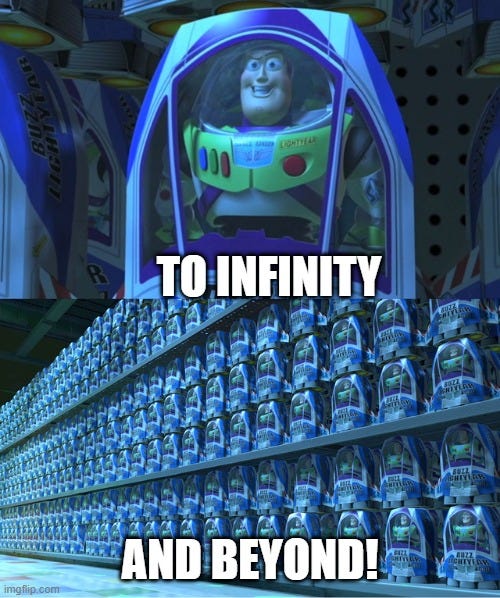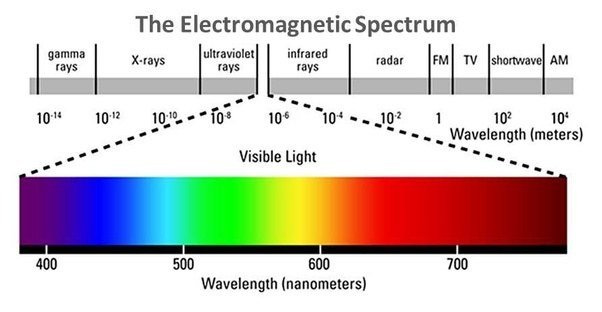"We know what happens to people who stay in the middle of the road. They get run over!" -Aneurin Bevan
Find other articles on Mathematical Beauty here.
This article will be used as a point of reference for other serious and important articles.
There is a statement called the "infinite monkey theorem" about the "technical-ish possibility, but infinitesimal probability" (my summary) of the possibility of a monkey typing out one of the great works of Shakespeare at random from a typewriter or keyboard. For a moment, I'll leave alone the possibility that Shakespeare wasn't the true playwright, or that the monkeys are staff writers at the Washington Post.
Though seemingly whimsical, the infinite monkey theorem may be one of the most important mathematical results for the practical public to understand. I'm not even kidding!
Any reader who likes can read the Wikipedia article and take it on good faith that the probability that a long random string of letters results in a Shakespeare play (the average word count over 37 works is 22,595) is terribly small, but specifically, given Wikipedia's suggested 90-character pool, there are approximately
ways to type so many words at an average of just six characters per word (seven including the space). Let's not quibble over word length—this number is enormous. For comparison, if you take the number of stars in the known universe, and multiply that number by itself 10,000 times over, you still don't get close. If you take the number of atoms in the known universe, and multiply that much larger number by itself 3,000 times over, you still don't get close!
Large numbers quickly become hard for most people to comprehend, so I wanted to make this last point absolutely clear because it quickly hits home that even a primate as advanced as Yuval Noah Harari isn't likely to craft a Shakespeare play no matter how many times we run a simulation, not matter how fast he waves his hands (within known physical limits).
But I'll go a step further…
Harari's Amazing Monkey Machine
"Out, out, brief candle! Life's but a walking shadow, a poor player that struts and frets his hour upon the stage and is heard no more. It is a tale told by an idiot, full of sound and fury, signifying nothing." -William Shakespeare, Macbeth
In order to leap from the infinite monkey theorem to practical applications of the point, I'll employ a construct: Harari's Amazing Monkey Machine (HAMM).
Imagine an epic machine as large as our solar system, filled with tiny little monkeys with tiny little keyboards. Is it likely that one of them would stumble upon one of 37 Shakespearean manuscripts before their candle (the sun) burns out? (Don't ask me why monkeys need a candle to type randomly, but they get downright pissy in the pitch black and the whole affair turns into a feces flinging festival.)
No, but this epic machine is nowhere near as powerful as the HAMM. Our HAMM is jam-packed with the sound and fury of more furry monkeys than you can imagine. The HAMM goes beyond engineering perfection—even beyond the limits of fanciful projects such as Dyson spheres. The HAMM tests all known physical limitations of computational horsepower—or monkeypower, as it were. To test the limits of the HAMM, we move beyond even the Futurists and their Singularity golden calf.
But not quite that far. We cannot and will not reach…infinity. But we'll try damn hard.
The HAMM Metrics
For HAMM size, let's use
Given that Pluto's average distance from the sun is a bit less than 4 billion miles, this is a reasonable gauge of the size of some conception of our solar system (I don't have to give two Hararis whether Pluto is a planet). Let us also give the sun a one billion year life span.
Next, we note that the smallest amount of energy that could do any kind of energetic computational task is the wavelength of a photon. The wavelengths of photons vary depending on the source from which they are emitted.
This is characterized by the equation,
where c is the speed of light (which is faster than Operation Warp Speed), and f is the frequency of the wave. Now, let's take a boundary-pushing approach that goes beyond HAMM-handed errors that we might unknowingly commit in the engineering process. Let's choose a wavelength larger than the Pluto-diameter of our solar system:
That sound you might have just heard was the collective gasp of all engineers in the known universe. That's because this wavelength is exceptionally large—dwarfing even Scott Adams's considerable estimation of his own intellect. Let no one say that we skimped on construction costs!
Now, it's time to step into the energy physics of the discussion. Don't worry—this doesn't go any further than an advanced high school course in physics (or Physics 101 at the local university). It's the thought-construction of the HAMM that is the conceptual leap.
Walking the Planck
Now, let us compute the frequency of our photonic wave:
Wow! That's…not very frequent. But it takes this exceptional photon several hours to do its wave dance, if you're watching from an orthogonal frame (because you're just that interested). Going forward, I'll use hertz (Hz) as the inverse of seconds.
This brings us to Planck's photon energy equation:
where h is the Planck constant. In Joules, the energy of this photon is,
This is orders of magnitude lower in Joules than most all of the photons you might experience in daily life—even lower in energy than Jeb Bush.
Why did we compute the energy of this sloth-like photon?
Glad you asked, mysterious voice. What we need is a comparison of the unit of computation (changing 0's to 1's and vice versa…analogous to punching keys on a keyboard) to the energy produced by all the stars in the known universe.
All of them?
All of em. What we want is the raw limit of a HAMM beyond the vast imaginations of even the most confused, brainwashed transhumanists. We aim to beat them at their own game—punch straight through their bullshit Matrix.
Well, shit, carry on!
Thank you. I will.
Powering Up the HAMM
Let's convert time and Joules to Watts in order to know how much power is required over the time scale of a billion years to perform a single, modest computation in the HAMM.
Watts cool about the HAMM is that it does considerable computation on just a little energy. And that's the point—we want to know if a true fantasy machine can thumb through an enormous number of possibilities by brute force until some of the data outputs are recognizable masterpieces.
And now for our moment of truth!
For the Astrophysicists reading—screw your bolometrics. We're going to turn up the power of the stars. Because star power is everything, and we want to be conservative in our calculations. We're going to upgrade the power of each star in the known universe in a way much like elevating a Jersey Shore star into Keanu Reeves status.
Our sun is a powerful star whose energy output is around
Let's bump this up to 10 to the 30th power, and assume that the rest of the stars in the known universe have similar output. This will account for strange features of quasars, mental attributes of gray aliens, and the collective talents of friends of Jean-Luc Picard.
Now, we compute…the computations (number of them) performed by the HAMM assuming that it can handle the collective energy output of all the stars in the known universe:
I'll skip the process of counting the monkeys or computer chips that we can jam in our HAMM. We have a highly conservative upper bound for the number of computations the HAMM can perform, and it's still hundreds of thousands of orders of magnitude away from the number of manuscripts needed to produce a single Shakespearean manuscript. There is no "one in a million". It's, "one in a million million million million…" with more "millions" than words in two full Shakespeare plays.
Technically-ish, the HAMM could stumble on a masterpiece, but "unlikely" does not even begin to describe the chances of a successful outcome. And this is why I asked my local Congressional official to slip this into a bill as an earmark [after sort of implying that I bought Jeffrey Epstein's laptop at auction].
But quantum computing…
Doesn't make monkeys type faster! No! Just…no! Unless you squeeze the HAMM into the quantum computer to take advantage of quantum state computing, it still feeds discrete outputs to typewriters at a limiting rate. Good luck with that. I'm not funding your therapist. Voting against that.
A Stepping Stone Argument
Going forward, I will take this math as a starting point to make some important arguments such as the unlikelihood that the SHA256 encryption algorithm used in Bitcoin will ever be brute force hacked, the unlikelihood that any single cryptocurrency wallet address will ever be created twice, and the extreme difficulty in engineering a robust quasi-species viral swarm in a laboratory.
Note: It is perfectly possible that writing this all up with a headache, I've made a mistake or three. If that is the case, please speak up and I'll try to punch numbers back into a keyboard like a good monkey.




















I understood none of that, beyond the first few paragraphs, but enjoyed it immensely. Highly amusing!
"Watts cool about the HAMM..."
Crying with laughter. Love it. Matthew, you are helping keep me sane in these crazy times.